Supreme Court Hears Argument On Referendum Banning Affirmative Action
Should states have the right to ban affirmative action? The Supreme Court will decide that this term.
Yesterday, the Supreme Court heard arguments in a case out of Michigan in one of the perennial controversial topics that come before it every few years like clockwork, affirmative action. Unlike in previous years, when the case before the Court dealt with admissions standards at the University of Michigan, as it did in 2002, or the University of Texas, as it did just this past term, this case deals with a referendum approved by the voters of Michigan that bars the use of race-based preferences of any kind at any of the state’s public universities:
WASHINGTON — Just four months after the Supreme Court largely ducked the question of whether the University of Texas may take account of race in its admissions decisions, the justices heard arguments on Tuesday about whether Michigan’s voters violated the Constitution by forbidding race-conscious admissions plans at that state’s public universities.
The new question led to a lively argument that illuminated the justices’ very different understandings of the meaning of equal protection, the workings of the political process and the value of affirmative action programs. The court appeared closely divided, with the five more conservative justices seeming generally inclined to uphold the ballot measure.
The measure, known as Proposal 2, was a response to Grutter v. Bollinger, a 2003 Supreme Court decision that upheld the use of race as one factor of many in law school admissions to ensure educational diversity. Proposal 2, approved in 2006 by 58 percent of Michigan’s voters, amended the State Constitution to prohibit discrimination or preferential treatment in public education, government contracting and public employment.
Groups favoring affirmative action sued to block the part of the law concerning higher education. The United States Court of Appeals for the Sixth Circuit, in Cincinnati, ruled last year that the initiative, which amended the State Constitution, violated the federal Constitution’s equal protection clause.
On Tuesday, John J. Bursch, Michigan’s solicitor general, told the justices that Proposal 2 was plainly constitutional. “It does not violate equal protection to require equal treatment,” he said.
But Mark D. Rosenbaum, a lawyer with the American Civil Liberties Union, which represents a group of applicants, students and faculty members, said Proposal 2 violated equal protection principles by restructuring the state’s political process and making it harder for disfavored minorities to press for change.
The court seemed divided along ideological lines.
“It’s not a racial classification,” Justice Antonin Scalia said of the ballot initiative. “It’s the prohibition of racial classifications.”
Justice Ruth Bader Ginsburg saw matters differently. “We can’t put hurdles in the way of a disadvantaged minority,” she said.
The lawyers, for their part, offered varying accounts of the impact of Proposal 2 and similar measures. Mr. Bursch said minority admissions in Michigan were affected only modestly in the year after Proposal 2 was adopted. Later statistics are unreliable, he said, because many students chose not to identify themselves as members of a single racial or ethnic group on a new form.
In California, which banned race-conscious admissions plans at the state’s public universities in 1996, “what they discovered was that underrepresented minority students have higher G.P.A.’s, that they take more technology, engineering and math classes, and they have a graduation rate that is 20 to 25 percent higher than it was before,” Mr. Bursch said. Texas, he said, saw similar trends in the years that affirmative action programs were barred there.
“What the California and Texas experiences have demonstrated is that there are good, positive reasons why the voters might want to try a race-neutral alternative,” Mr. Bursch said.
Chief Justice John G. Roberts Jr. went further, asking whether some minority students actually suffered a disadvantage by being admitted into academic settings where they could not thrive. He referred to research on this “mismatch” theory from Richard Sander and Stuart Taylor Jr., who had filed a brief supporting Michigan.
“Do we have to assume in your favor that these definitely are beneficial to particular minority groups?” Chief Justice Roberts asked, referring to race-conscious admissions plans.
Shanta Driver, a lawyer for the Coalition to Defend Affirmative Action, Integration and Immigrant Rights and Fight for Equality By Any Means Necessary, responded: “Certainly the minority voters of Michigan believe them to be, because 90 percent of black voters in Michigan voted against” the ballot measure there.
“If you look at the law schools, the medical schools, the professional schools now in the state of Michigan, there’s been a precipitous drop in underrepresented minority enrollment in those schools,” she continued. “We are going back to the resegregation of those schools because of the elimination of affirmative action.”
More generally, she said, the Michigan measure is unconstitutional because it fails “to protect minority rights against a white majority.”
The statement provoked a sharp response from Justice Scalia. “My goodness,” he said, “I thought we’ve held that the 14th Amendment protects all races. I mean, that was the argument in the early years, that it protected the blacks. But I thought we rejected that.”
In 1969 and 1982, the Supreme Court struck down measures disfavoring minorities on the grounds that they unfairly restructured the political process. Those precedents may be at risk in the new case, and much of the argument was devoted to their precise meaning and whether they could be reconciled with a decision endorsing the Michigan measure.
Lyle Denniston at SCOTUSBlog goes into more detail about the argument:
As the Court heard the case of Schuette v. Coalition to Defend Affirmative Action (docket 12-682), it appeared that Kennedy holds what is likely to be the decisive vote. With Justice Elena Kagan not taking part, there are at most three votes to strike down Michigan’s ban on affirmative action in the admissions process, and very likely four votes to uphold it.
That leaves Kennedy, and if he joins in opposition to the state’s voter-approved “Proposal 2,” the Court could split four to four and the measure would be struck down, as the U.S. Court of Appeals for the Sixth Circuit had ruled. But the Court no doubt will strive to avoid that outcome, and Kennedy seems to have the power to see that it doesn’t happen.
The opponents of “Proposal 2″ persuaded the Sixth Circuit that the measure skews the political process in the state, so that minorities who want public universities to make race one of the factors in choosing entering classes have a much harder challenge than, say, those who want the children of alumni to receive a preference. That is the “political process theory” that had emerged in two Supreme Court rulings — one in 1969, the other in 1982 — striking down voter-approved measures that took away public benefits favored by racial minorities.
From his very first question in the hearing, Justice Kennedy said he was focusing tightly on whether that theory should be brought to bear against Michigan’s ban. This was just after Justice Sonia Sotomayor (who emerged as the strongest critic of “Proposal 2″) had commented that the people of Michigan had done exactly the same thing as the voters in those prior cases had to scuttle minority-preferred policy options. She saw the situations as “identical.”
Kennedy began looking for factual differences between the prior cases and the one now before the Court. And then he showed real fascination with suggestions by Michigan’s Solicitor General, John J. Bursch, as to how the Court could distinguish the prior precedents without having to overrule them. Bursch seemed to sense that the Court would not be ready to overrule those precedents outright, but their embrace of the “political process theory” does remain a potential hurdle for “Proposal 2.”
(…)
Aside from the Chief Justice, the probable votes to uphold “Proposal 2″ apparently would come from Justices Samuel A. Alito, Jr., and Antonin Scalia (as well as Justice Clarence Thomas, who said nothing on Tuesday but is known to be a foe of affirmative action in general). Those Justices became more involved when an American Civil Liberties Union lawyer, Mark D. Rosenbaum of Los Angeles, went to the lectern to challenge “Proposal 2.”
Instead of joining in those thrusts, Kennedy went back to exploring just when the “political process theory” would work to inhibit changes in existing affirmative action policy, at varying levels of state government. It was clear that he was trying to define a line at which that theory would actually break down, thus limiting its utility as a way to judge the constitutionality of a measure like “Proposal 2.”
Without getting into the minutae of the legal argument regarding previous case law that the Justices were dealing with in these oral arguments, it strikes me that the Michigan referendum is likely to be upheld, perhaps with some limitation that allows for the idea that affirmative action as a remedial measure could still be permissible if found acceptable by a court. For one thing, as Ilya Somin notes in a post on the case today, there’s a wide difference between saying that the Constitution, via the 14th Amendment, permits government entities to enact race-based preferences and saying, essentially, that it requires that they do so. In effect, that would be what ruling against the Michigan referendum would mean in effect. Indeed, it would also arguably mean that existing affirmative action policies could never be repealed, which in and of itself is a fundamentally absurd position.
Ideally, there ought to be no preferences based on race enacted by public institutions, whether they are for purposes of admission to Colleges or Graduate Schools, hiring, or for any other purposes. Obviously, there are circumstances were it was necessary to relieve a long history of discrimination and, in some cases, its arguably the case that some of those measures are still necessary. As a general rule, though, affirmative action of any kind ought to be the exception rather than the rule, and the goal ought to be moving toward a day when those programs can be phased out, rather than lobbying, as some organizations do, in favor of the proposition that anyone who questions their utility or necessity is arguing out of some racial animus.
With specific regard to the Michigan referendum, it seems perfectly acceptable to me. Based on the record as I understand it, there’s little evidence that it was adopted with the intent to discriminate. Instead, it seems to have clearly been a response to the 2002 Supreme Court decision noted above, and the decision of the people of Michigan that they didn’t wish to have this policy implemented in their state any longer. It passed in 2006 58% to 42%, a margin of nearly 600,000 votes. Absent clear and convincing evidence of racial bias, which doesn’t seem to exist here, I don’t see any reason why the Supreme Court shouldn’t uphold and, indeed, expect that this is exactly what will happen.\
Here’s the transcript of the oral argument. Audio recordings will be available at this link next week.
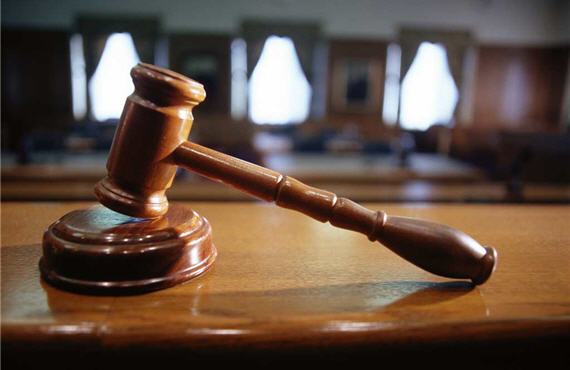

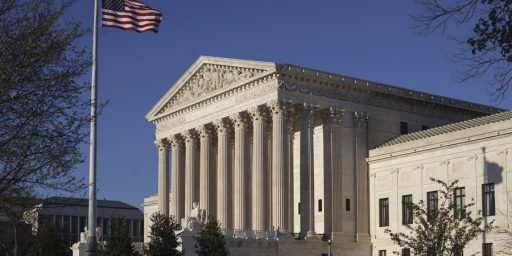
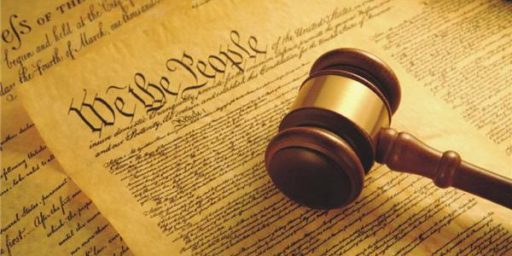

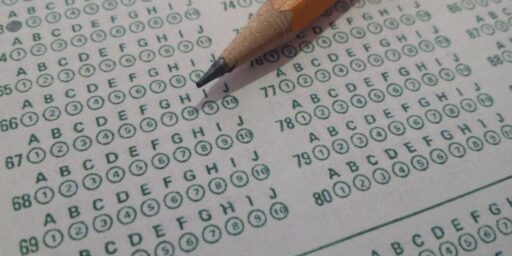
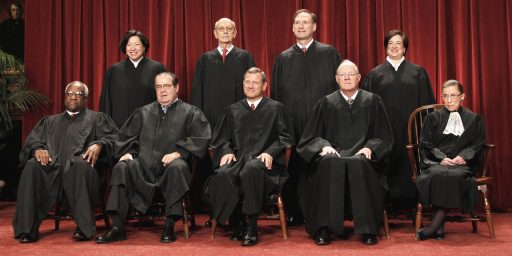
The only thing you need to know about this is Scalia’s comment…
I was unaware that people appeared before the Court to argue that the 14th Amendment protects only blacks. Justice Scalia has the effect of making me appreciate justices like Stevens and Blackmun a great deal.
As a side note, it is always interesting to me that in prominent affirmative action cases, whenever a very well-qualified white student is denied admission to a public university, people always point to those minority admittees who had lower GPAs and test scores, and never to those lesser qualified white students who had lower grades and test scores. The implication is always that affirmative action got the lesser qualified minority admitted, while the lesser qualified white persons somehow had other important factors that counter balanced those lower test scores and grades.
All of that said, Michigan’s referendum result will stand.
George Bush went to Harvard and Yale.
There’s your affirmative action for “the whites”.
@al-Ameda:
Remember when the University of Michigan got caught red-handed with their numeric scores for things like a perfect SAT score, being a legacy, or being black. On a 150 point scale being black was worth 20 points, having a perfect SAT was worth 12 points, and being a legacy got a student around 5 points. Anyone who says that legacy is equivalent to race is lying.
I also find it odd that Progressives get upset about GW Bush’s legacy at Yale but always ignore that Al Gore was a legacy admission to Harvard (along with his four children) and John Kerry was a legacy admit to Yale. I will believe progressives care about legacies when they pass Department of Education regulations to put an end to legacy admissions.
Package deal: affirmative action becomes entirely class-based, and legacy admissions are no more. I think progressives would take the deal.
I don’t think Conservatives will. Since your ideology is all about preserving privilege, class-based AA is almost as much of an affront as racial AA.
@superdestroyer:
I would say that anyone who says that legacys are not often admitted despite their lack of good grades and adequate test scores is delusional.
Has anyone looked at GPA vs. family background (i.e., class)? I get the feeling that it’s more a problem of poor kids needing a boost up rather than directly racial.
MIT did a look at SAT scores vs. GPA and noticed that SAT scores consistently under-predicted the GPAs that female students earned. So they added that to their weighing in admissions. This is the sort of Affirmative Action I’m in favour of.
Stanford, on the other hand, at one point decided it would accept all women who had graduated from a California high school. As expected, quite a few were admitted who couldn’t hack it and bombed completely. This is the sort of Affirmative Action I’m not in favour of.
And yes, it would be great to get rid of legacy admissions but good luck. It’s one of the reasons that alumni donate to their colleges.
P.S. yes, and I am female.
@C. Clavin: sheet, obama got into harvard too…..all by hisself! but seriously, why do blacks need so much help these days- 60 years of being democrat sheep and little to show for it? keep voting for it, it’s what you is. meanwhile, wave after wave of immigrants (blacks too) seem to have found their way to being “American” and a way to be successful…………. on their own…..just sayin’. so what is it that you need, $3.50?
@superdestroyer: algore was different, he actually came from a segregationist family and …..something! look, global warming……………..ahhhhhhhh.
@grumpy realist:
There have been studies of GPA, academic achievement, class, and race. There first thing it shows is that the children of white collar black families under perform and are on the same levels as the families of white blue collar families.
Whne making comparisons of GPA and demographics, the first thing that has to be corrected for is major. Females would look better for graduation versus SAT because more Females major is soft majors such as education, social work, etc versus more males majoring in the hard sciences and engineering. It is one of the reasons that females graduate at a higher rate than males.
Many universities have gotten rid of legacy admissions. There is also the developmental admissions that the Ivy League uses to admit the children of the super-rich.
@superdestroyer: Dude, did you notice I said this happened at MIT? You know, the place where they insist even the music majors take chemistry, physics, and calculus?
Don’t be more stupid than you usually are.
@grumpy realist:
As noted, yes — there have been studies of academic success correcting for class/income. They tend to show that black (and to a lesser extent Hispanic) students as a group underperform students of comparable class from other ethnic backgrounds.
This is part of what led John McWhorter to write his controversial 2000 book Losing the Race: Self-Sabotage in Black America. In that book, McWhorter (who is black, and a professor of Linguistics at Stanford) argues rather passionately for an end to affirmative action, because it helps to perpetuate a pernicious culture of victimhood.